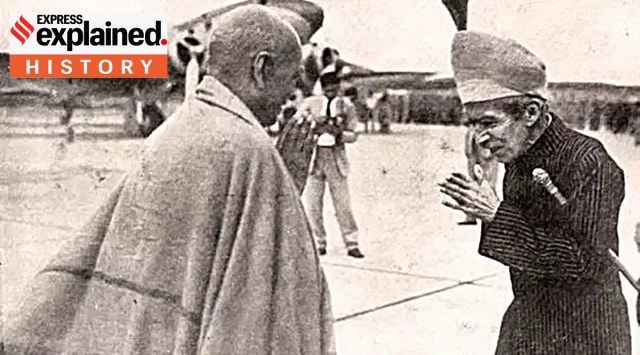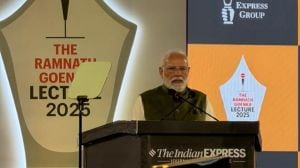Explained: 75th anniversary of Operation Polo and ‘Police Action’ in Hyderabad
Operation Polo, the military action launched by the Indian Army on September 13, 1948, to integrate the princely state of Hyderabad. How was it conducted on the ground?
 The Nizam of Hyderabad state, Mir Osman Ali Shah, had the intention of keeping his state as an independent entity and did not join India or Pakistan after Independence. (Twitter/ @kishanreddybjp)
The Nizam of Hyderabad state, Mir Osman Ali Shah, had the intention of keeping his state as an independent entity and did not join India or Pakistan after Independence. (Twitter/ @kishanreddybjp) Wednesday marks the 75th anniversary of Operation Polo, the military action launched by the Indian Army on September 13, 1948, to integrate the princely state of Hyderabad. The Nizam of Hyderabad was dithering on joining India ever since Independence on August 15, 1947. The military offensive in Hyderabad state was termed as ‘Police Action’ at the time by the then home minister Sardar Vallabhbhai Patel and the Nizam’s forces surrendered to the Indian Army by September 18.
What was the background against which Operation Polo was launched?
The Nizam of Hyderabad state, Mir Osman Ali Shah, had the intention of keeping his state as an independent entity and did not join India or Pakistan after Independence. The Nizam took advantage of the fact that the Indian government got preoccupied with the Kashmir war soon after Independence and all focus and resources were diverted toward tackling the Pakistani threat to Jammu and Kashmir.
The Nizam signed a standstill agreement with India in November 1947. This essentially meant that a status quo would be maintained between the Indian dominion and the Hyderabad state till a solution was found to the imbroglio. The agreement was signed for a period of one year during which the Indian government would not exercise any authority over Hyderabad and all conditions prevalent at the time of signing the agreement would continue.
Why was Operation Polo launched on September 13, 1948?
Situated in the Deccan, Hyderabad was one of the most populous and richest states and had 17 districts including Aurangabad (now in Maharashtra) and Gulbarga (now in Karnataka). The landlocked state had a majority Hindu population with the state administration almost entirely run by its Muslim rulers. There was no common border with Pakistan but the Nizam had every intention to have fraternal relations with that country.
The Nizam’s administration in Hyderabad had taken advantage of the standstill agreement signed with India and the lull which followed to increase the number of its irregular force called Razakars which was led by Maj Gen SA El Edroos, the Arab commander in chief of the Hyderabad state forces. The excesses of the Razakars on the predominantly Hindu population of the state, their belligerence along the state borders through cross-border raids, the overtures being made to Pakistan and the intention to establish an independent country in the heart of India were the reasons why the Indian government decided to act against Hyderabad and remove the threat of secession.
How were the Nizam’s forces placed vis-a-vis the Indian Army?
Hyderabad state forces numbered little less than 25,000 and only a fraction was well-trained. By one estimate, there were not more than two brigades worth of opposition. There were a substantial number of Razakars in the state but these ill-trained volunteers were more of a nuisance than any particular military opposition.
The Prime Minister of Hyderabad, Mir Laik Ali, had boasted that if the Indian Army acted against the state, then a force of 1,00,000 troops was ready to meet the challenge. In the end, this proved to be a hollow claim and the Hyderabad opposition to the Indian Army crumbled within the first two days of the offensive.
The Indian forces were led by Maj Gen Jayanto Nath Chaudhuri, the General Officer Commanding of 1 Armoured Division, who later went on to become the Chief of Army Staff.
How was Operation Polo conducted on the ground?
The primary strike against Hyderabad state forces was led by Maj Gen Chaudhuri’s division from the west aided by subsidiary and supporting thrusts from north, south and east of the state.
The primary strike by 1 Armoured Division from the west included 1 Horse (less one squadron) and 9 Dogra (less one company). This strike element included a Smash Force comprising 3 Cavalry, 17 Horse (less one squadron) and one company of 9 Dogra.
There was a Kill Force led by 7 Infantry Brigade which comprised 2 Sikh, 1 Grenadier, 14 Rajpur and one squadron of 14 Horse.
Another component of the Western thrust was the Vir Force which comprised 9 Infantry Brigade, 3/2 Punjab and 2/1 Gorkha Rifles.
Another thrust was launched into Hyderabad from the Aurangabad axis and this included 4 Rajputana Rifles, 3/5 Gorkha Rifles, 17 Sikh and ad hoc tank and armoured car squadrons.
The Northern push into Hyderabad was led by Jabalpur (Independent) Sub Area with 18 Cavalry, 2 Jodhpur, 7/2 Punjab and 3 Sikh along with a company of the central police.
The eastern advance into Hyderabad was led by 2/5 Gorkha Rifles, 6 JAT, 6 Kumaon, 9/2 Punjab, 3 Sikh Light Infantry and one squadron of 17 Horse.
Southern thrust from Vijayawada comprised 5/5 Gorkha Rifles, Mysore Lancers and 1 Mysore Infantry.
When did Hyderabad forces surrender?
The Nizam of Hyderabad announced a ceasefire on September 17. On September 18, Maj Gen Chaudhuri entered Hyderabad city with his forces and Maj Gen El Edroos surrendered to him. Maj Gen Chaudhuri was later appointed the Military Governor of Hyderabad.
Havildar Bachhitar Singh of 2 Sikh was awarded the first Ashoka Chakra of Independent India posthumously for his role in Operation Polo. He laid down his life on September 13, 1948, while advancing to Naldurg, which is now in Maharashtra but at the time was part of Hyderabad state.





- 01
- 02
- 03
- 04
- 05

































